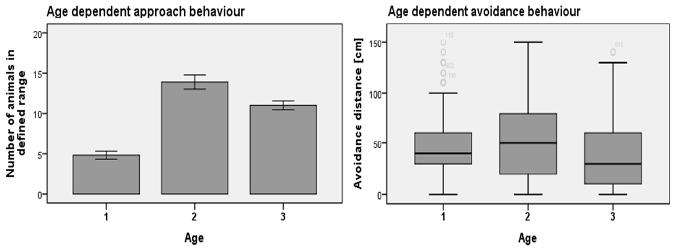Results & Discussion
Experiment 1

- The observer location in the chicken house influenced the number of animals that voluntary approached an observer.
- Significantly more birds approached an observer in location one, which was an area close to the main entrance door, compared to location two (U= 6012, p< 0.001), three (U= 5720, p< 0.001) and four (U= 6004, p< 0.001).
- The avoidance distance was not affected.
As location one was the area close to the main entrance door, the birds in this area might have been more habituated towards human contact. Zulkifli et al. (2002: 'The effects of regular visual contact with human beings on fear, stress, antibody and growth responses in broiler chickens') showed, that regular visual contact reduces the fear of humans broiler chicken display as they learn to prediction management practices. However, this would imply that the same birds stay in the same area, what has not been intensively investigated and confirmed yet.
Experiment 2
The results of the influence of daytime and age on the applied tests are listed in the Table below.
| |||||||||||||||||||||||||||||||
Daytime dependence
- For Danish broiler chicken assessed in this study, no correlation between daytime and the outcome of the ADT (r= 0.23, p= 0.35) or the SPT (r= 0.01, p= 0.56) was found.
- Overall, the birds displayed the same median avoidance distance towards an unknown observer in the morning as in the evening.
- When tested at different ages in the rearing cycle, no differences between the median avoidance distances of morning and evening observations has been found.
- Significant differences in the voluntary approach between morning and evening hours have been found when looking at the different age classes. However, the results are not consistent.
Many regulatory systems within a bird are affected by light and hence, the applied lighting scheme may also have an impact on the bird’s behaviour. However, the existence of these patterns might be depending on the management system and especially, the lighting regime, as light is a major factor regarding broiler chickens performance and activity. The results of the study coincide with previous research stating that long-daylenghts do not only disturb diurnal patterns of broiler chicken but also might prevent them from establishing a diurnal rhythm (Schwean-Lardner, 2012: 'Impact of daylength on behavioural output in commercial broilers').
Age dependence
- Age affected the avoidance and approach behaviour of commercial broiler chicken.
- Both behaviours had a maximum at three weeks of age and declined prior to slaughter.
- Avoidance behaviour was lowest prior to slaughter while the approach was lowest at one wee of age.
The results of this project agree with earlier studies who found that broiler chickens activity peaked at three weeks of age (Nielsen et al., 2003: 'Effects of qualitative and quantitative feed restriction on the activity of broiler chickens'). As broiler chicken are the fastest growing farm species they are prone to several welfare problems. Health issues, a lower walking ability and an increased stocking density at the end of the rearing cycle reduce the mobility of the birds drastically.
However, an appreciable number of birds voluntary approached prior to slaughter. This might be because the ability to perform various activities but not the motivation of fast growing broilers decreased with age because of an increased live weight (Bokkers and Koene, 2003: 'Behaviour of fast-and slow growing broilers to 12 weeks of age and the physical consequences'). Further, the different tests applied are ‘not alternative ways of measuring fear, but rather measures of different aspects of the relationship between people and animals’ (de Passillé and Rushen, 2005: 'Can we measure human–animal interactions in on-farm animal welfare assessment? Some unresolved issues'). Hence, the avoidance distance test gives an overview about the general fear of the birds towards human as the approach is forceful and independent from the motivation of the animals. In contrary, the stationary person test measures the voluntary approach, depending on feelings, motivation and emotions, hence, the reaction will not be as strong as when performing an ADT.

Responsible for this page:
Director of undergraduate studies Biology
Last updated:
06/16/15
